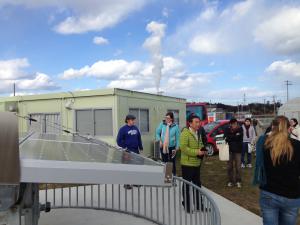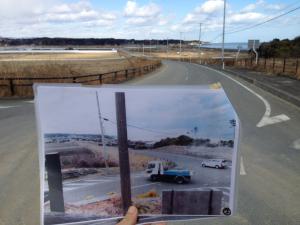This February, we undertook a study tour of the Soma area to get an idea of the reconstruction efforts after the March 11 triple disaster in Japan. This time, we started in my area, Fukushima city, and went to the radiation information plaza. I was surprised because I had never seen the information plaza before. It’s on a main street, but there is no indication that it’s there. The plaza had a large amount of information about the current radiation situation, demonstrations of radiation monitoring equipment, and even had specialists on hand to answer any questions. I though that it was a fantastic resource for the people of Japan to learn more about their situation, and I wish the same kind of information was available for people abroad as it would help them to understand that Fukushima is safe. After a short bus ride, we arrived in Soma. We had a delicious lunch of local seafood, and proceeded to the fishing co-op to learn about the status of the fishing industry. There was a lot of information about the current efforts to monitor fish radiation and re-open the waters for fishing, but one fact stuck out the most: before the nuclear disaster, there were 700 boats operating in the Fukushima area, and now only a few dozen participate in the environmental monitoring. I was saddened to hear this, and got an appreciation for the impacts of the disaster on the people on the coast. We moved on to a strawberry farm which had recovered from some serious damage during the tsunami. After picking some delicious strawberries we visited a shrine and stable for horses used in the Soma Nomaoi festival, which is one of the three famous festivals of the Tohoku area. I am very excited to watch it in July. After such a long day, we went to sleep. The next morning was a poignant experience. We got on a bus and took a tour of the areas near the ocean that were damaged by the tsunami. This tour took us through an area where overnight occupation is forbidden, but residents can still return during the day. Like the previous study tour, I saw houses that were swept off of their foundations, leaving only concrete behind, but due to the ban, I also saw damaged houses that have not been repaired even though the incident happened 3 years ago. I even saw some cars that were still upturned in the fields because no one had come back to clear them. At a stop point 10 km from the Daiichi Nuclear Plant, our guide showed us pictures taken of the same area during the approach of the tsunami. It was heartbreaking to see coastal houses in the picture, and bare rock in real life. The reality of the situation around Soma and Minami-Soma was an important experience, but the tour ended on a hopeful note. We visited the Minami-Soma Agri-park where a former director of TELCO has set up an interactive center for children to learn about solar power and renewable energy through fun demonstrations. His enthusiasm and passion for his new calling was inspiring, and we saw the same traits in every Soma resident we talked to during these short two days. With people like this on their, I’m sure the region will return better than ever. I can’t wait to visit again and support them some more. I’ve attached two pictures: One of the tsunami-affected area and the before picture, and one of our time at the Agri-park. Thank you for reading. |  |
| Summary |








